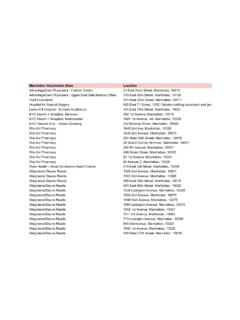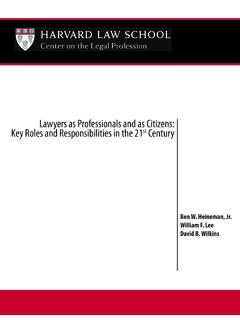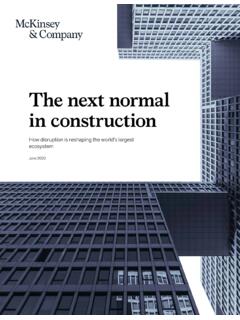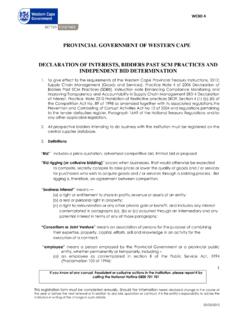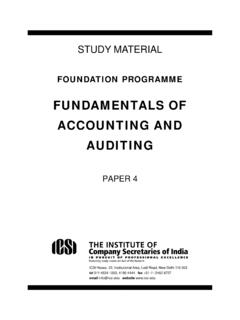Transcription of The Economic Impact of the Fashion Industry - JEC Report Final
1 Feb. 6, 2015 The Economic Impact of the Fashion Industry Overview As the economy continues to grow and evolve, one of the many bright spots of our new creative economy is the Fashion Industry . With a growing number of high-value jobs that pay high wages, Fashion is now having a big Impact not only in Fashion centers on the coasts, but also in smaller cities around the country. Fashion is a $ trillion global Industry , with more than $250 billion spent annually on Fashion in the United States, according to Industry Fashion and apparel industries employ million people in the United States and have a positive Impact on regional economies across the New York City and Los Angeles are the two largest Fashion hubs in the United States, with over two-thirds of all Fashion designers employed in these But they are not the whole story, and cities such as San Francisco, Nashville, and Columbus are beginning to reap Economic benefits, including high-paying jobs in Fashion Fashion is a structurally diverse Industry , ranging from major international retailers to wholesalers to large design houses to one-person design shops.
2 It employs people across occupations including Fashion designers, computer programmers, lawyers, accountants, copywriters, social media directors, and project managers. According to a Report by the California Fashion Association, manufacturing is only a fraction of the modern apparel Industry as it is a highly sophisticated Industry involving Fashion and market research, brand licensing/intellectual property rights, design, materials engineering, product manufacturing, marketing and finally, distribution. 5 Apparel Manufacturing Produces High- Fashion , High-Value Products The Fashion Industry in America has changed dramatically over the past century. In 1931, the Garment District in New York was home to the highest concentration of apparel manufacturers in the Many of these jobs have since moved offshore. Over the past two decades, employment in the apparel manufacturing Industry has declined sharply, from almost 940,000 in 1990 to about 144,000 in However, while many apparel manufacturing jobs have left the United States, new high-value Fashion Industry jobs are being created in New York, Los Angeles, San Francisco and other cities.
3 As with many industries in the manufacturing sector, the United States now concentrates on the high-value parts of the apparel global supply chain: research and development (R&D), design and Jobs in these fields require more education and training and they also hold the prospects of higher The Economic Impact of the Fashion Industry Page 2 The apparel manufacturing Industry currently runs a trade deficit. In 2014, apparel exports totaled roughly $6 billion, while imports were about $82 Over one-third of apparel imports come from China (36 percent), with Vietnam (11 percent), Bangladesh (6 percent), Indonesia (6 percent), and Mexico (5 percent) rounding out the top While many apparel products are manufactured overseas, much of the value that goes into them is generated in the United States. Various studies note that conventional trade statistics may overstate the size of our trade deficit because they fail to fully capture the value added at different stages of the design and development Other consumer products, such as smart phones, electronics and toys, operate with similar business models.
4 Profits in these industries derive more from establishing a strong brand name, researching market needs, and finding a niche than from scaling up production of a product and pushing it out to Recent studies focusing on Apple s iPod an example of a product designed and distributed in this country but largely manufactured overseas have found that many of the highest-value, highest-wage activities take place right here in the United While much apparel manufacturing now takes place overseas, what remains in the United States is focused on high- Fashion , high-value, quick-turnaround, high-margin orders. Computer-aided design helps designers turn concepts into samples, and helps manufacturers move from prototype to finished product on an accelerated timetable. Cities like New York and Los Angeles retain manufacturing bases that support the Fashion Industry .
5 Apparel manufacturing represents three-in-10 manufacturing jobs in New York Nearly two-in-10 manufacturing firms in Los Angeles are in the apparel Fashion Industry Creates High-Paying Jobs Overall, Fashion - and apparel-related industries employ million workers, in professions requiring a range of education and The number of people working as Fashion designers in the United States has grown by over 50 percent in the past 10 years to over 17, Fashion designers the profession at the heart of the Industry 's creative process are concentrated in apparel industries, namely manufacturing and wholesale merchandising. Across industries, Fashion designers earn an average of $73,600 annually (see Table). The apparel manufacturing Industry employs more than 144,000 workers. While there are still occupations such as sewing machine operators, tailors, and textile machine operators who earn lower wages, today s manufacturing jobs include a number of higher-paying occupations.
6 These include market research analysts and marketing specialists, who earn $59,750 annually on average, and computer professionals, who earn $67,110 on average. Also within the production stages, fabric and apparel patternmakers earn an average of $53,800. The Economic Impact of the Fashion Industry Page 3 The wholesale apparel merchandising sector employs roughly 141,000 individuals. These include graphic designers earning $50,120 on average; production, planning and expediting clerks earning $47,630 on average; and installation, maintenance and repair workers earning $43,440 on average. The majority of Fashion and apparel jobs are in the retail sector, with nearly million individuals employed throughout the country in retail establishments. These jobs, on average, pay $26,000 per year, but even within the retail sector there are higher-wage jobs for accountants, auditors, buyers, purchasing agents and others.
7 Marketing and sales managers, for example, earn over $87,000 on average. The Economic Impact of the Fashion Industry Page 4 New York City is the Fashion Capital of the World New York City is considered by many to be the Fashion capital of the world ahead of Paris, Milan, and According to the New York City Economic Development Corporation (NYCEDC), an estimated 900 Fashion companies have their headquarters in New York City and the city is the largest retail market in the country, generating more than $15 billion in annual According to NYCEDC, the Fashion Industry employs more than 180,000 people in New York City; approximately half of them work in The Industry pays nearly $11 billion in wages and generates almost $2 billion in tax revenue each Fashion trade shows, showrooms, and Fashion shows attract more than half a million visitors annually to New York New York City s pre-eminent role in the Fashion world is showcased during the city s semiannual Fashion Weeks, which are held in February and September each Fashion Week generates close to $900 million in total Economic Impact each year, including an estimated $532 million in direct visitor spending, according to an analysis by the The Economic benefit from Fashion Week surpasses events such as the New York City Marathon ($340 million), the 2014 Super Bowl in New Jersey (about $550 million), and the Open ($800 million).
8 26 New York is a hub for major Fashion publications such as Women s Wear Daily, Vogue and Harper s Bazaar, and home to some of the largest advertising companies in the world. The city has sophisticated media and marketing resources that designers can utilize to promote their products and build their brands. New York is the headquarters of such internationally recognized brands as Ann Taylor, Brooks Brothers, Calvin Klein, Rocawear and DKNY. Fashion Industry Expands Footprint in Cities Around the Country In addition to New York and Los Angeles, which have the highest concentrations of Fashion designers in the country, several cities are building their own reputations for Fashion design. Columbus, Ohio, is home to a number of major apparel companies including Express, Abercrombie & Fitch, DSW and L Brands. According to an analysis by Economic Modeling Specialists International, Ohio s capital city has more than 500 Fashion designers who earn an average of $26 an In Nashville, Tennessee, more than 275 Fashion designers earn an average of $30 an hour, close to the prevailing wages for designers in New York and Los More than 500 Fashion designers work in San Francisco, where Levi Strauss & Co.
9 And Gap Inc. are based, earning an average of $38 an Seattle and Dallas are also cities that have attracted a significant number of Fashion Fashion is Part of the Creative Economy More than 200 schools across the country offer Fashion -related programs and prepare students for high-wage jobs in the Fashion These programs build skills that are marketable not only in Fashion , but across industries. For instance, 5 percent of Fashion designers worked in the motion picture and video industries in The Economic Impact of the Fashion Industry Page 5 Three of the most prominent design schools are located in New York City Parsons The New School for Design, Pratt Institute, and Fashion Institute of Technology (FIT). Los Angeles is home to 14 private and public undergraduate schools with programs dedicated to apparel design and merchandising. Rhode Island School of Design and Columbus College of Art and Design also are well-known for their strong design programs.
10 Some prominent schools Report more than an 80 percent placement rate for recent graduates. In addition to preparing students for careers in the Fashion Industry , many design schools have a significant positive Economic Impact in their areas. For example, FIT attracts more than 200,000 visitors each year to its Chelsea campus, including 105,000 visitors to the Museum at FIT, and generates more than $280 million of spending in New Fashion Clusters Promote Knowledge-Sharing and Efficiency Gains The Fashion Industry is characterized by clusters of activity, whether in the large Fashion hubs of New York or Los Angeles or in smaller hubs in a number of states. This mirrors trends in a range of industries, where clusters often develop in certain regions for example, technology and computing in Silicon Valley, the film Industry in Los Angeles, and life sciences in a number of areas including suburban Maryland and North Carolina s Research Research shows there are Economic benefits when businesses in a particular Industry cluster together in close proximity.
